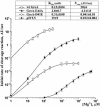Transcript cleavage factors GreA and GreB act as transient catalytic components of RNA polymerase
- PMID: 14633991
- PMCID: PMC291851
- DOI: 10.1093/emboj/cdg610
Transcript cleavage factors GreA and GreB act as transient catalytic components of RNA polymerase
Abstract
Prokaryotic transcription elongation factors GreA and GreB stimulate intrinsic nucleolytic activity of RNA polymerase (RNAP). The proposed biological role of Gre-induced RNA hydrolysis includes transcription proofreading, suppression of transcriptional pausing and arrest, and facilitation of RNAP transition from transcription initiation to transcription elongation. Using an array of biochemical and molecular genetic methods, we mapped the interaction interface between Gre and RNAP and identified the key residues in Gre responsible for induction of nucleolytic activity in RNAP. We propose a structural model in which the C-terminal globular domain of Gre binds near the opening of the RNAP secondary channel, the N-terminal coiled-coil domain (NTD) protrudes inside the RNAP channel, and the tip of the NTD is brought to the immediate vicinity of RNAP catalytic center. Two conserved acidic residues D41 and E44 located at the tip of the NTD assist RNAP by coordinating the Mg2+ ion and water molecule required for catalysis of RNA hydrolysis. If so, Gre would be the first transcription factor known to directly participate in the catalytic act of RNAP.
Figures







Similar articles
-
Distinct functions of N and C-terminal domains of GreA, an Escherichia coli transcript cleavage factor.J Mol Biol. 1998 Feb 20;276(2):379-89. doi: 10.1006/jmbi.1997.1545. J Mol Biol. 1998. PMID: 9512710
-
The carboxy-terminal coiled-coil of the RNA polymerase beta'-subunit is the main binding site for Gre factors.EMBO Rep. 2007 Nov;8(11):1038-43. doi: 10.1038/sj.embor.7401079. Epub 2007 Oct 5. EMBO Rep. 2007. PMID: 17917675 Free PMC article.
-
Domain organization of Escherichia coli transcript cleavage factors GreA and GreB.J Biol Chem. 1997 Mar 14;272(11):7201-10. doi: 10.1074/jbc.272.11.7201. J Biol Chem. 1997. PMID: 9054416
-
Conformational toggle triggers a modulator of RNA polymerase activity.Trends Biochem Sci. 2006 Aug;31(8):424-6. doi: 10.1016/j.tibs.2006.06.004. Epub 2006 Jul 11. Trends Biochem Sci. 2006. PMID: 16815708 Review.
-
A Two-Way Street: Regulatory Interplay between RNA Polymerase and Nascent RNA Structure.Trends Biochem Sci. 2016 Apr;41(4):293-310. doi: 10.1016/j.tibs.2015.12.009. Epub 2016 Jan 25. Trends Biochem Sci. 2016. PMID: 26822487 Free PMC article. Review.
Cited by
-
Regulation of transcriptional pausing through the secondary channel of RNA polymerase.Proc Natl Acad Sci U S A. 2016 Aug 2;113(31):8699-704. doi: 10.1073/pnas.1603531113. Epub 2016 Jul 18. Proc Natl Acad Sci U S A. 2016. PMID: 27432968 Free PMC article.
-
Regulation through the RNA polymerase secondary channel. Structural and functional variability of the coiled-coil transcription factors.J Biol Chem. 2006 Jan 20;281(3):1309-12. doi: 10.1074/jbc.C500405200. Epub 2005 Nov 18. J Biol Chem. 2006. PMID: 16298991 Free PMC article.
-
The A12.2 Subunit Is an Intrinsic Destabilizer of the RNA Polymerase I Elongation Complex.Biophys J. 2018 Jun 5;114(11):2507-2515. doi: 10.1016/j.bpj.2018.04.015. Biophys J. 2018. PMID: 29874602 Free PMC article.
-
Backtracking behavior in viral RNA-dependent RNA polymerase provides the basis for a second initiation site.Nucleic Acids Res. 2015 Dec 2;43(21):10421-9. doi: 10.1093/nar/gkv1098. Epub 2015 Oct 22. Nucleic Acids Res. 2015. PMID: 26496948 Free PMC article.
-
Regulation of Transcript Elongation.Annu Rev Microbiol. 2015;69:49-69. doi: 10.1146/annurev-micro-091014-104047. Epub 2015 Jun 24. Annu Rev Microbiol. 2015. PMID: 26132790 Free PMC article. Review.
References
-
- Borukhov S. and Goldfarb,A. (1993) Recombinant Escherichia coli RNA polymerase: purification of individually overexpressed subunits and in vitro assembly. Protein Expr. Purif., 4, 503–511. - PubMed
-
- Borukhov S. and Goldfarb,A. (1996) Purification and assay of Escherichia coli transcript cleavage factors GreA and GreB. Methods Enzymol., 274, 315–326. - PubMed
-
- Borukhov S., Sagitov,V. and Goldfarb,A. (1993) Transcript cleavage factors from E.coli. Cell, 72, 459–466. - PubMed
-
- Borukhov S., Laptenko,O. and Lee,J. (2001) Escherichia coli transcript cleavage factors GreA and GreB: functions and mechanisms of action. Methods Enzymol., 342, 64–76. - PubMed
-
- Chen Y., Ebright,Y.W. and Ebright,R.H. (1994) Identification of the target of a transcription activator protein by protein–protein photocrosslinking. Science, 265, 90–92. - PubMed
Publication types
MeSH terms
Substances
Grants and funding
LinkOut - more resources
Full Text Sources

